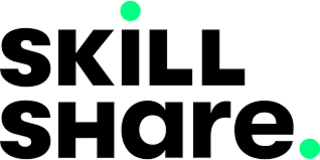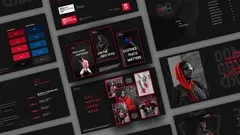
Dynamic Brand Identity: Designing Logos That Evolve 
Paula Scher, partner at Pentagram's New York office, demonstrates her process of creating a dynamic branding system that can be adapted across mediums. In this 70-minute class, students will explore research methods, design principles, and strategies for creating a logo that evolves over time. Through this class, students will gain the skills to create a recognizable, dynamic brand identity. ▼
ADVERTISEMENT
Course Feature
![]() Cost:
Cost:
Free Trial
![]() Provider:
Provider:
Skillshare
![]() Certificate:
Certificate:
Paid Certification
![]() Language:
Language:
English
![]() Start Date:
Start Date:
On-Demand
Course Overview
❗The content presented here is sourced directly from Skillshare platform. For comprehensive course details, including enrollment information, simply click on the 'Go to class' link on our website.
Updated in [March 06th, 2023]
In this 70-minute class, Paula Scher, partner in the New York office of Pentagram, will walk students through her process of creating a liquid identity—a recognizable, dynamic branding system that can be adapted across mediums. Students will learn how to research an organization’s goals, develop a series of design solutions, simplify them to their essence, and stretch them to their limits as they apply to animation, products, signage, architecture, and more. Through the lens of Paula’s past work experiences, students will gain insight into how to create logos that capture an organization’s ethos while also adapting to time and other variables. They will also learn how to develop rules to define the limits of their own typeface. By the end of the class, students will have a better understanding of how to create a fluid and complete company logo design.
[Applications]
After this course, students will be able to apply the concepts learned to create dynamic brand identities that can be adapted across mediums. They will be able to research an organization's goals, develop a series of design solutions, simplify them to their essence, and stretch them to their limits. Students will also be able to create logos that capture an organization's ethos while also adapting to time and other variables. Additionally, they will be able to develop rules to define the limits of their own typeface and design logos that look like they are members of the same family, but are not identical.
[Career Paths]
Recommended Career Paths:
1. Brand Identity Designer: Brand identity designers create logos, typography, color palettes, and other visual elements that represent a company or organization. They must be able to research the organization’s goals and develop a series of design solutions that can be adapted across mediums. This role is becoming increasingly important as companies look to create a cohesive and recognizable brand identity.
2. Graphic Designer: Graphic designers create visual concepts, using computer software or by hand, to communicate ideas that inspire, inform, and captivate consumers. They develop the overall layout and production design for various applications such as advertisements, brochures, magazines, and corporate reports.
3. UX/UI Designer: UX/UI designers are responsible for creating user-friendly interfaces for websites and applications. They must be able to understand user needs and create designs that are both visually appealing and functional. This role is becoming increasingly important as companies look to create a seamless user experience.
4. Motion Graphics Designer: Motion graphics designers create animated graphics for television, film, and the web. They must be able to create visuals that are both visually appealing and technically accurate. This role is becoming increasingly important as companies look to create dynamic and engaging visuals for their products and services.
[Education Paths]
Recommended Degree Paths:
1. Bachelor of Arts in Graphic Design: This degree program provides students with the skills and knowledge necessary to create effective visual communication through the use of typography, illustration, photography, and other design elements. Students will learn how to create logos, websites, and other digital media, as well as how to use software such as Adobe Creative Suite. This degree is becoming increasingly popular as the demand for graphic designers continues to grow.
2. Master of Fine Arts in Visual Communication Design: This degree program focuses on the development of creative and innovative visual communication solutions. Students will learn how to create logos, websites, and other digital media, as well as how to use software such as Adobe Creative Suite. This degree is becoming increasingly popular as the demand for graphic designers continues to grow.
3. Bachelor of Science in Digital Media Design: This degree program focuses on the development of digital media solutions. Students will learn how to create logos, websites, and other digital media, as well as how to use software such as Adobe Creative Suite. This degree is becoming increasingly popular as the demand for digital media designers continues to grow.
4. Master of Science in Digital Media Design: This degree program focuses on the development of digital media solutions. Students will learn how to create logos, websites, and other digital media, as well as how to use software such as Adobe Creative Suite. This degree is becoming increasingly popular as the demand for digital media designers continues to grow. Additionally, students will learn how to create dynamic and evolving brand identities that can be adapted across mediums.
Pros & Cons

Broad view of Brand Design

Understand thinking pattern

Learn from Paula Scher

Gems for making client comfortable

Learn about brand identity

Great teacher and professional

Equipped to handle branding projects.

Head busted

Not just designed for scaling.
Course Provider

Provider Skillshare's Stats at AZClass
Dynamic Brand Identity: Designing Logos That Evolve walks you through the process of developing a fluid and complete company logo design. First, you identify a nonprofit that interests you. You'll then come up with a design kit that includes a logo, typographic system, color palette, iconography and methodology to represent different parts of the organization in a variety of media, from digital to physical spaces and always start by getting to know your customer. Paula walks you through research best practices and common reasons organizations choose to rebrand.
Discussion and Reviews
0.0 (Based on 0 reviews)
Explore Similar Online Courses

Lumion for Architects

Foundations of International Psychiatry

Python for Informatics: Exploring Information

Social Network Analysis

Introduction to Systematic Review and Meta-Analysis

The Analytics Edge

DCO042 - Python For Informatics

Causal Diagrams: Draw Your Assumptions Before Your Conclusions

Whole genome sequencing of bacterial genomes - tools and applications

Branding Success Ultimate 2018 Branding Yourself Materclass

How To Build A Super Brand


Start your review of Dynamic Brand Identity: Designing Logos That Evolve